Sperm Whale - Physeter macrocephalus
Cachalot
Sperm Whales Statistics
Maximum length: 18m (60ft) males
/ 12.5m (41ft) females, average around 16m.
Adult
weight: 63 tonnes males max. / 27 tonnes females max,
average around 35 tonnes
Life span: 60-70 years
Sexual maturity: 7 - 13 years females / 18 - 21 years
males
Gestation: 14 - 15 months
Birth length:
3.5 - 4.5m (11 - 15ft)
Birth weight: 500 - 800kg
(1100 - 1800lbs)
Dive duration: 90 - 140mins
Feed on: deep water squid
Distribution:
all oceans, preference for deep waters, several distinct
geographical sub-groups
Current world population:
1 million / pre-whaling - 2.4 million
Conservation
status: Vulnerable
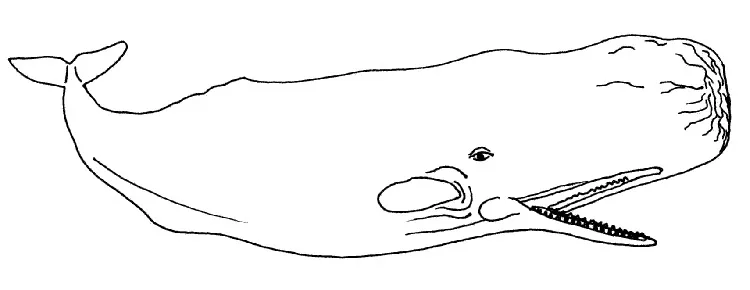
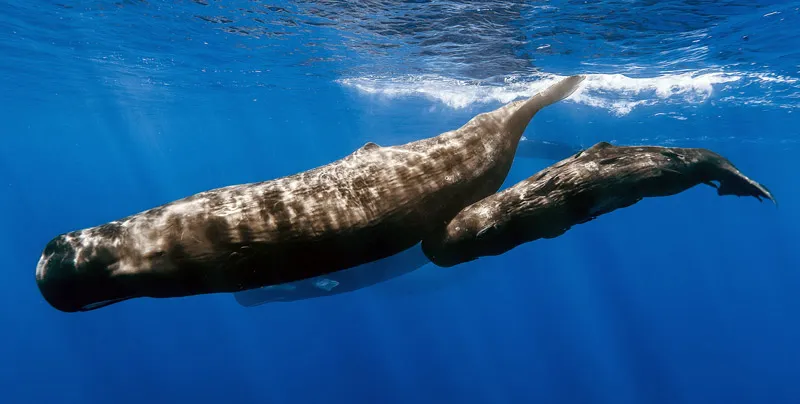
A pod of sperm
whales off the coast of Mauritius
Only males are found in Antarctic waters. There is a large degree of sexual dimorphism (difference in appearance between males and females) with males being about one and a half times longer, but considerably heavier than the females, about twice as much.
Sperm whales are Odontocetes - toothed whales rather than filter feeders like the other large whales, they are the deepest diving of all whales, spending the longest underwater too. They do this to catch their prey of giant squid in the dark ocean depths. Most dives are thought to be about 400-600m in depth, but they may be able to dive as deep as 3000m.
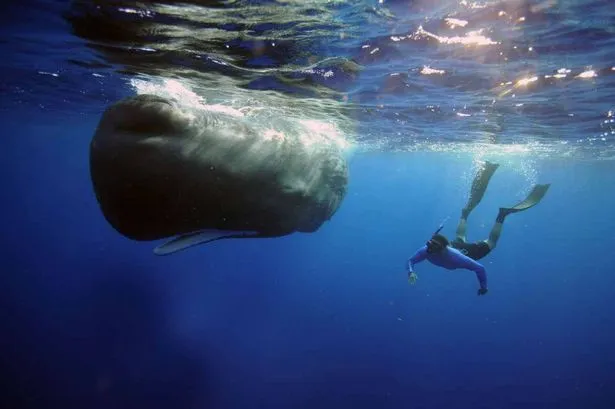
Snorkeler with sperm whale
 The "blow"
of the sperm whale is the most characteristic of any whale.
It is directed forwards and to the left, it projects about 5m.
On calm days or when there is very little wind, this characteristic
of the blow can be easily used to identify sperm whales even
at some considerable distance.
The "blow"
of the sperm whale is the most characteristic of any whale.
It is directed forwards and to the left, it projects about 5m.
On calm days or when there is very little wind, this characteristic
of the blow can be easily used to identify sperm whales even
at some considerable distance.
Sperm whales are easily the largest toothed carnivores on earth. The baleen whales are also carnivores as they eat other animals, but they do so by capturing hundreds or thousands at a time by filter feeding and so are not usually classed with whales that have have teeth and hunt individual prey.
Unusually, sperm whales only have teeth in their lower jaw, these fitting into depressions in the upper jaw. There are from 17 to 29 pairs of teeth and the depressions in the upper jaw show tiny undeveloped teeth. The teeth are large, up to 10" (25cm) long in old males, they are conical and very strong being designed for grasping and disabling slippery prey such as squid rather than being sharp cutting teeth as in many other animals.
Orcas will sometimes hunt other whales even the giant blue whale, but they never approach the sperm whale with it's formidable lower jaw, perhaps the largest and most effective weapon possessed by any animal.
The area around a sperm whales mouth, lips and lower jaw is coloured white against the dark grey / brown of the rest of the animal. This coloration is thought to assist the whales when they are in the dark ocean depths hunting for squid with the possibility that there may even be phosphorescent bacteria that live on the white skin so making light - most squid are readily attracted to light in the darkness.
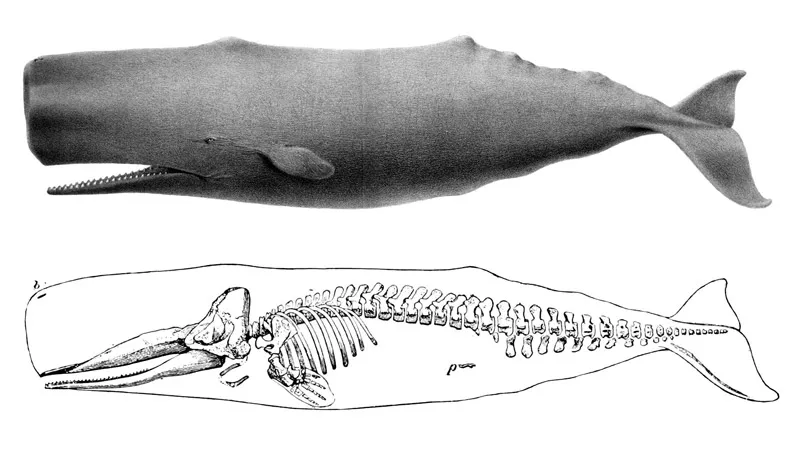
Sperm whale drawing and skeleton
Of particular note in the sperm whale is the huge spermaceti organ in the head, the reason for the head being from 1/4 to a 1/3rd of the length of the animal. Clearly this is an enormous structure and while it has similar counterparts in other Odontocetes - many dolphins and small toothed whales have a bulbous "melon" with a similar internal structure - it is developed to an extreme in the sperm whale. The organ itself is full of oil which becomes a solid waxy substance at room temperature. About 25 to 40 barrels of whale oil could be had from a sperm whale of average size. Extremes of over 100 barrels are found in legend.
The reason for this organ is unknown as is so much whale biology, due to the whales being so difficult to study. There are several theories as to what this organ is for and it may well have more than one of these functions:
-
Echolocation - as sperm whales are known to hunt squid in the dark ocean depths, they need some way of finding them. Dolphins are known to use echolocation and the "melon" of some species is known to be involved in this. The spermaceti organ may be used to focus and control the beam of sound that the whale uses for echolocation or even for stunning its prey by focusing sound.
- A diving / buoyancy aid - The waxy oil within
the organ has a melting point of 32 degrees Celsius. By
controlling blood flow to the organ (and therefore its temperature),
the whale might be able to control whether the wax is liquid
or solid. If the wax is solid, it contracts and becomes
more dense, making the whale sink better. When melted again,
the wax expands, making the whale less dense and more buoyant.
This could be a way of helping the whale to control dives and ascents. Sperm whales are known to dive deeper and for longer than any other animal. Sufficient heat is produced and stored during a dive in the muscles to melt the wax on the way back to the surface. - Battering ram / shock absorber - a relatively recent suggestion is that the spermaceti organ in males enables them to fight each other while competing for females by swimming directly at each other and battering with their heads. Similar behaviour is certainly seen in many other species of animal, on land and sea, the fact that the males are so much larger than the females implies that direct competition may take place between the males. That the sperm whale is capable of using its head in this way is graphically demonstrated by the wreck of the whale ship Essex (87 feet long with a 21 man crew) in 1820 which was repeatedly rammed amidships by a large stricken male sperm whale and sent to the bottom of the ocean marooning the crew in a small life boat. This event was the inspiration for Moby Dick.
Ecology and behaviour
Unlike baleen whales, which form only temporary bonds, sperm whales live in extended family units of up to 50 individuals, that for the females are lifelong associations. These schools of sperm whales that form are of several type segregated by age and status, for instance, matriarchal nursery schools (females and calves), juvenile schools, bachelor schools and bull schools have been seen. The large males in high latitudes towards the poles tend to be solitary.
The nursery schools in particular are very stable and individual whales may remain in the same school for several years. Sperm whales have been seen to exhibit altruism to other members of the school in similar ways to those seen in dolphins and other smaller Odontocetes. Baby-sitting and assisting injured school members are behaviours seen by other mothers and young males in such schools.
Sperm whales are found in all oceans and latitudes from the equator to the edge of the polar pack ice. They frequent deep waters which means that they are usually found offshore unless depths of more than 200m are found near to shores for example off volcanic and oceanic islands. Most commonly they are found near submarine canyons at the edges of the continental shelf, but may also be seen in mid-ocean. These deep waters are where the large squid they prey on are found.
Sperm whale stomachs have been found to contain a whole range of cephalopods (squid, octopuses and cuttlefish), deep-sea fish, and non-food items. Cephalopods are thought to be the major prey. In some parts of the world, sperm whales have been known to steal the catch from longlines set by fishing boats. The skin of most sperm whales bears the scars from the suckers of the squid that they feed on.
Sperm whales are thought to take around the same biomass of food from the oceans as humans. Fortunately though, the deep sea squid that sperm whales feed on is not currently targeted by man as a fishery and so there is no direct competition.
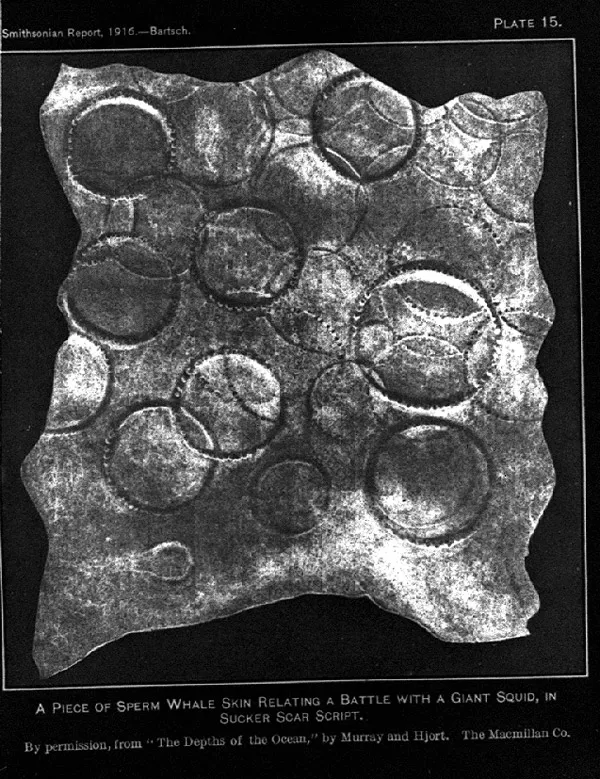
A piece of sperm whale skin with Giant Squid sucker
scars
From: "The Depths of the Ocean: A General
Account of the Modern Science of Oceanography Based Largely
on the Scientific Researches of the Norwegian Steamer 'Michael
Sars' in the North Atlantic", by Murray, J. and J.
Hjort. Publisher "Macmillan and Co., Ltd." in "1912".
821 pages
Picture credits: Snorkeler with sperm whale, courtesy Geckochasing - Creative Commons Attribution-Share Alike 3.0 Unported license / A pod of sperm whales off the coast of Mauritius, courtesy Gabriel Barathieu - Creative Commons Attribution-Share Alike 2.0 license
